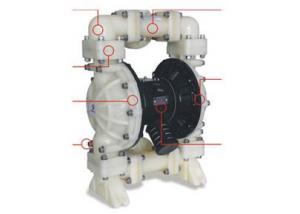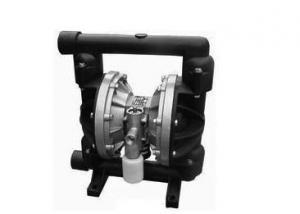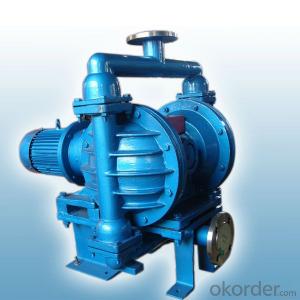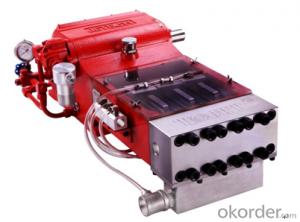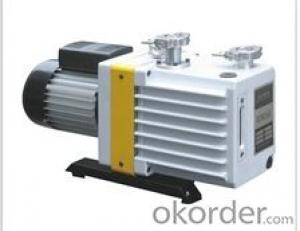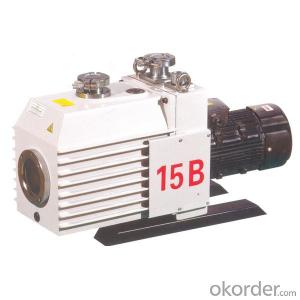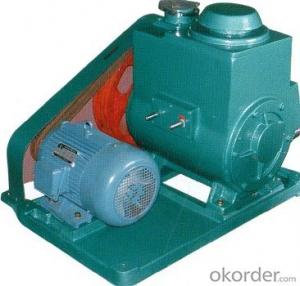Vacuum Pumps 2X Series
- Loading Port:
- China Main Port
- Payment Terms:
- TT OR LC
- Min Order Qty:
- -
- Supply Capability:
- -
OKorder Service Pledge
Quality Product, Order Online Tracking, Timely Delivery
OKorder Financial Service
Credit Rating, Credit Services, Credit Purchasing
You Might Also Like
2X-Series
The type two-stage oil-sealed mechanical pump system varactor vacuum pump, which has the characteristics of the exhaust directly to the atmosphere is suitable for electronics, refrigeration, electric light, chemical, medical, bottle lamps, packaging, dehydrating, drying and other industries. (But can not be used for extraction of oxygen is too high, there are explosive, corrosive to metal on the vacuum oil from the chemical reactions, as well as containing the particles, dust, gas, also can not serve as pumps and compressors use.Motor power:0.37~5.5KW,extract capacity:2~7L/S,Limit vacuum:6×10-1Pa。
Performance Table
Type | off-gas quick result (L/S) | limited pressure (Pa) | mating power (kw) | inner diameter of air inlet (mm) | noise of vent (dB) | total weight (kg) | Shape&size(L×W×H) (mm) |
2X-70 | 70 | 6×10-2 | 5.5 | 80 | ≤86 | 333 | 91×66×70 |
2X-30 | 30 | 6×10-2 | 3 | 65 | ≤80 | 230 | 81×48×57 |
2X-15 | 15 | 6×10-2 | 2.2 | 40 | ≤78 | 202 | 79×53×54 |
2X-8 | 8 | 6×10-2 | 1.1 | 40 | ≤76 | 158 | 79×43×54 |
2X-4 | 4 | 6×10-2 | 0.55 | 25 | ≤75 | 66 | 56×34×40 |
- Q: Is an air pump noisy?
- Yes, an air pump can be noisy.
- Q: How is three-phase air pump changed into single phase?
- Take one by one between the two voltage 400 volt electrodeless capacitor, and a power single-phase capacitor motor with no other line, a power capacitor connected to either end (forward or backward), the capacity of the capacitor according to the motor power selection (refer to electrical manual, such as one thousand Duowayue capacitance to 400 V, 20uf) at this time, the motor output power is only 55% of the original, the original work can only reach half the maximum pressure. I practice to help people change the connection, very simple, very successful.
- Q: Probably is such a big cylinder, the left is 16 open book, fish tank is 30 cm high, mouth diameter is 18 cm, pump small, may be 2W? Fish is 3, the kind of carp, in this condition, about how long will the oxygen pump open?
- The aquarium is usually open because the fish tank is small
- Q: Can an air pump be used for filling up oxygen tanks?
- An air pump is not suitable for filling up oxygen tanks. Air pumps are designed to compress and pump regular air, which contains about 21% oxygen along with nitrogen and trace amounts of other elements. On the contrary, oxygen tanks are specifically designed to store and contain pure oxygen. Pure oxygen is utilized for diverse medical purposes and must be kept at high pressure to ensure its availability in emergencies or for patients with respiratory conditions. Consequently, specialized equipment like oxygen concentrators or oxygen compressors is required to safely and efficiently fill up oxygen tanks with pure oxygen.
- Q: Are there any specific safety features to prevent overheating in an air pump?
- Yes, there are specific safety features in air pumps to prevent overheating. One common safety feature is a built-in thermal protection switch. This switch monitors the temperature of the air pump and automatically shuts it off if it exceeds a certain temperature threshold. This prevents the pump from overheating and potentially causing damage or starting a fire. Additionally, air pumps often have built-in cooling mechanisms such as fans or heat sinks to dissipate heat and keep the internal components at a safe operating temperature. These cooling mechanisms help prevent overheating by promoting airflow and heat transfer away from the pump. Some high-end air pumps also come with temperature sensors that constantly monitor the internal temperature and adjust the pump's operation accordingly. For example, if the temperature starts to rise, the pump may slow down or reduce its output to prevent overheating. It's important to note that even with these safety features, it is still essential to use the air pump responsibly and avoid blocking the airflow or operating it in extremely hot environments. Regular maintenance and cleaning of the pump can also help prevent overheating by ensuring that dust or debris does not clog the cooling mechanisms.
- Q: Can an air pump be used for inflatable trampolines?
- Indeed, inflatable trampolines can certainly benefit from the use of an air pump, as it is often the preferred means of inflation. Notably, an air pump offers a swift and effective manner of inflating the trampoline, guaranteeing its proper inflation and readiness for utilization. Nevertheless, it is imperative to consult the explicit instructions accompanying the inflatable trampoline to ascertain its compatibility with the air pump, and to adhere to any manufacturer-provided guidelines or recommendations.
- Q: What is the glass tube that the air pump connects to the air compressor?
- It's called a pressure regulating valve! Go to the mechanical and electrical market, and remember that the pressure is the range of that gauge. Then the size of the interface, dozens of domestic, imported only 800
- Q: How can the air conditioning compressor be refitted into a pump?
- Transfer door to novice or buy ready-made, that thing is too advanced
- Q: I have a lot of fish. But they died in a few days. Now the fish are black Marie with Kong Qiao, found that just a day of water. They began to water upstream, also run amok, others say is hypoxia, died in the night of two hole qiao. I changed the water on time, and also disinfected the fish tank, the water used is also trapped water. Why not? Is it because the weather is sultry?. Do the fish lack oxygen? Should I buy an oxygen pump or a filter?. I don't quite understand. Which one is suitable for me?
- They say they are wrong, black Marie and red arrows are on the fish tail, your tank water pump. Do you have some fish in it, it looks better, now who still keep on fish. No ornamental value. Is not good, dirty mug.
- Q: Can an air pump be used for inflatable sports equipment?
- Yes, an air pump can be used for inflatable sports equipment.
Send your message to us
Vacuum Pumps 2X Series
- Loading Port:
- China Main Port
- Payment Terms:
- TT OR LC
- Min Order Qty:
- -
- Supply Capability:
- -
OKorder Service Pledge
Quality Product, Order Online Tracking, Timely Delivery
OKorder Financial Service
Credit Rating, Credit Services, Credit Purchasing
Similar products
Hot products
Hot Searches
Related keywords



